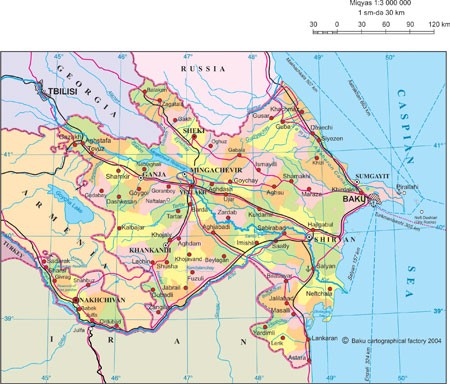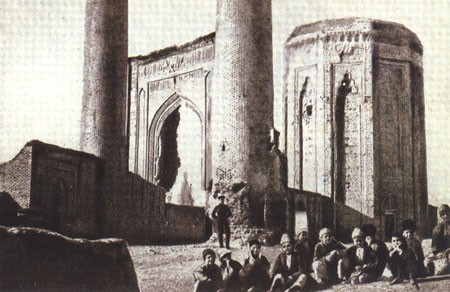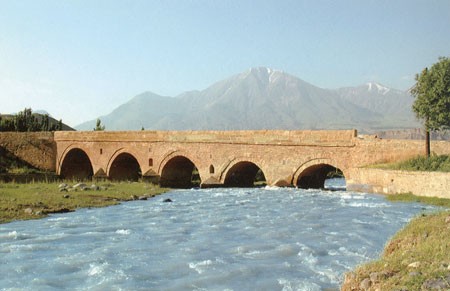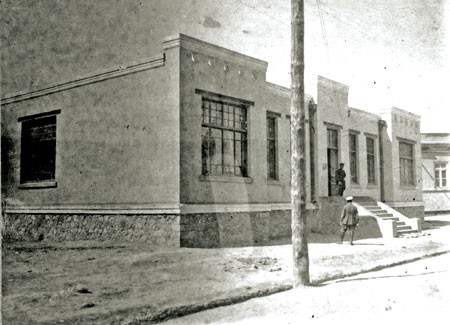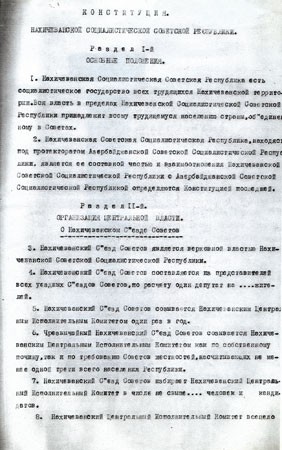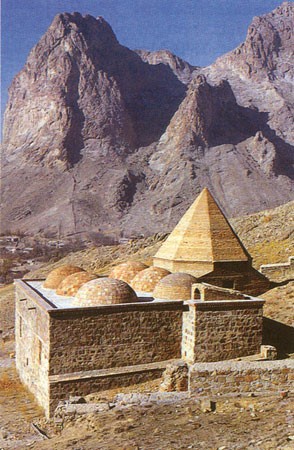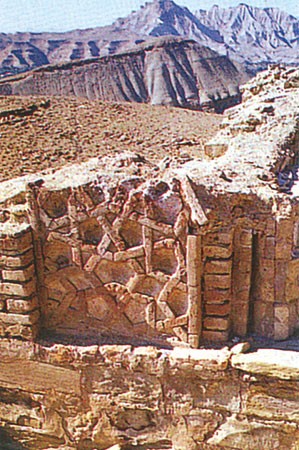Look at a map of Azerbaijan and you will see a relatively small area of land, separated from the rest of the country by the territory of modern-day Armenia. This is the Nakhchivan Autonomous Republic which marks the 85th anniversary of its creation this year. Atakhan Pashayev, director of Azerbaijan´s National Archive, looks back at how Nakhchivan gained its status as an autonomous part of Azerbaijan.
For years Armenians have tried to take possession of Nakhchivan and nearly achieved their objective in December 1920 when the Dashnak authorities were overthrown in Armenia and Soviet power was established. Under Moscow´s diktat, the leadership of the Azerbaijani Soviet Socialist Republic declared it would make a concession, and the Armenian SSR announced officially that Nakhchivan was an integral part of Armenia.
How did it happen that the Armenians´ dreams did not come true and an autonomous republic was established in Nakhchivan under the aegis of the Azerbaijani Republic?
The Armenians tried to derive maximum advantage from the situation that arose as a result of World War I and the Russian Revolution and to take the opportunity to tear as much land as possible away from their neighbours. Occupying Nakhchivan was one of the Armenians´ foremost intentions. In 1918-20, when foreign invaders had supremacy in Nakhchivan, the Armenians repeatedly tried to get hold of Nakhchivani land. It was only the brave resistance of the Nakhchivan population and Turkey´s help that prevented
Soviet power in the south Caucasus
Soviet power was established in Azerbaijan in April 1920 when the 11th Army occupied the republic. An uncertain situation prevailed in Nakhchivan which was separated from Azerbaijan. However, Soviet Russia had clear aims for the South Caucasus - no matter what, to capture the region, which used to be a colony of tsarist Russia. In July 1920, units of the 11th Army crossed Zangazur and moved towards Nakhchivan. The first cavalry regiment of the 28th rifle division of the 11th Army moved through Gorus and Shahbuz and entered Nakhchivan City on 28 July. On the same day, Soviet power was proclaimed in the region, and the Nakhchivan Revolutionary Committee was set up. Its members included M. Baktashi, A. Qadimov and F. Mahmudbayov.On 10 August 1920, the chairman of the Nakhchivan Revolutionary Committee, M. Baktashi, sent a letter to the chairman of the Council of People´s Commissars of the Azerbaijani SSR, Nariman Narimanov. The letter read: “By the decision of the vast majority of the people of Nakhchivan, the country of Nakhchivan considers itself to be an integral part of the Azerbaijani Soviet Republic. The country of Nakhchivan which has always gravitated towards Azerbaijan was completely forgotten under the
old government and left without a head…Now, the Azerbaijani Soviet Republic represents a new dawn on the horizon for the population of the country of Nakhchivan.”
Armenia tries to gain Nakhchivan
However, the Armenians, who had claims on Nakhchivan, used all means at their disposal to hold onto part of Nakhchivan. On 28August 1928, the Politburo of the Central Committee of the Azerbaijani Communist Party (Bolshevik) discussed the situation in Nakhchivan. The Politburo heard a report by representatives of the Nakhchivani population and instructed the Azerbaijani Revolutionary Committee to clarify as a matter of principle the Nakhchivan issue and to identify a border line between Azerbaijan and Armenia that would be acceptable to Azerbaijan. The Politburo also instructed the Azerbaijani Revolutionary Committee together with the 11th Army´s Military Revolutionary Council to set up the bodies of Soviet authority in Nakhchivan. The Politburo decided to nominate a representative of the Central Committee to the post of extraordinary commissar for Nakhchivan. Mir Jafar Bagirov, who later became first secretary of the Communist Party of Azerbaijan, was seen as a candidate for this post.The Politburo also ordered that 30m manats be made available to the extraordinary commissar of the country of Nakhchivan, of which 10m was to be given to the new commissar and 20m to be transferred to the Shusha bank.
Interestingly, the Armenians, who could now see that Western countries would not help the Armenians seize their neighbours´ land, strove to make friends with Soviet Russia and Vladimir Lenin, hoping that in this way the right conditions would arise for Zangazur, Karabakh and Nakhchivan to be joined to Armenia.
In the summer of 1920, when military action was under way between Armenia and Soviet Russia on what had always been Azerbaijani land, political and diplomatic talks also continued between them. Without Azerbaijan´s participation, these talks considered Azerbaijan handing land to Armenia.
In this connection, Narimanov wrote to Lenin: “A terrible situation has arisen. The centre has recognized Georgia and Armenia´s independence but at the same time the centre is giving to Armenia indisputably Azerbaijani territories…”
Incidentally, Stalin´s opinion, as expressed in his speech at a joint plenum of the Central Committee of the Azerbaijani Communist Party and the Baku Committee in Baku on 9 November 1920, spoke volumes. He said that if you want to know to whom Zangazur and Nakhchivan belong, they cannot be given to the current government
in Armenia; they can be given only after Soviet power has been established there. About Azerbaijan, he said: “I do not favour Azerbaijan´s independence. One part of the Communists cannot be independent from the others.”
We should also note that this was not only Stalin´s idea but also the position on Azerbaijan taken by Lenin´s Bolshevik Party. A clear example of this was provided by a meeting of the political and organizational buros of the Central Committee of the Azerbaijani Communist Party on the day Soviet power was proclaimed in Armenia, 30 November. The meeting passed a decision that, “There is no border between Soviet Azerbaijan and Soviet Armenia,” and that Zangazur and Nakhchivan should go over to Armenia. The right to self-determination was given to the upper part of Karabakh. It fell to Nariman Narimanov to proclaim the decision.
Narimanov announced the 30 November decision at a solemn meeting of the Baku Soviet held to mark the establishment of Soviet power in Armenia on the morning of 1 December.
On 2 December, the Bolshevik leader in the South Caucasus, Sergo Ordzhonikidze, delivered to Lenin and Stalin as a matter of urgency the information about the Azerbaijani land that had been given to Armenia. On the same day, in a treaty signed between the Russian Federation and Soviet Armenia, Soviet Russia “indisputably recognizes” these territories as territories of Armenia. All this shows that the question of handing historic Azerbaijani land to Armenia had been settled in Moscow long before Soviet power was established in Armenia. Through these documents they wanted to formalize the issue.
Already on 3 December, Stalin sent a congratulatory telegram to the Armenian people, who had “suffered and experienced misfortunes”, saying that on 1 December Soviet Azerbaijan “voluntarily gives up the disputed provinces, and announces that Zangazur, Nakhchivan and Mountainous Karabakh are given to Soviet Armenia”.
The above events show the dual policy conducted by the Soviet authorities, under the leadership of the Communist Party, towards these two republics from their very first day in the South Caucasus and that they resorted to all possible means to give Armenia undisputed Azerbaijani land. However, the Nakhchivani population´s.
Nakhchivan´s people reject Armenia.
As soon as the region heard about the declaration adopted on 1 December 1920, the population of Nakhchivan, who had risen in a dramatic struggle against annexation by Armenia in 1918-20, announced their strong objection to the declaration. The leadership of the Azerbaijani Republic could see that the situation was becoming tense and sent Justice Commissar B. Shahtakhtinski to Nakhchivan on 15 December. At rallies held by Shahtakhtinski in Nakhchivan City, Sharur and Ordubad districts, the population said they supported the creation of an independent Soviet republic in Nakhchivan under the aegis of Azerbaijan. Interestingly, at rallies held by Armenian SSR representatives in Nakhchivan City and in Sharur´s Sadarak, Bash Norasen, and Yeyja villages the people also categorically demanded that Nakhchivan stay within Azerbaijan.
The firm position of the Azerbaijani population turned the Armenians´ plan for Nakhchivan on its head and prevented them from fulfilling their dream of taking over Nakhchivan. When a poll was conducted in early 1921 to discover the attitude of the Nakhchivani people towards the declarations by the Azerbaijani and Armenian revolutionary committees, 90 per cent of respondents said they wanted the Nakhchivan Autonomous Republic to stay within Azerbaijan. The importance of Turkey´s position on Nakhchivan should also be noted. The Turkish delegation constantly raised Nakhchivan´s fate in talks between Turkey and Soviet Russia. After long negotiations, Soviet Russia and Turkey signed a treaty on friendship and cooperation in Moscow on 16 March 1921. Article 3 of the treaty stipulated that an autonomous structure was to be established in Nakhchivan province, indicated in an appendix to the treaty, under the aegis of Azerbaijan, on condition that this protection not be ceded to a third country.
Article 5 of the Treaty of Kars, which was concluded on the basis of this treaty on 13 October 1921 in the city of Kars between the Armenian, Azerbaijani, and Georgian republics, and Turkey, with the participation of Soviet Russia, said that the Turkish government and the governments of Soviet Armenia and Soviet Azerbaijan agreed to the establishment of an autonomous structure under the aegis of Azerbaijan within the boundaries of
Nakhchivan´s autonomous status formalized
We should note that even though Nakhchivan was governed as an autonomous structure of the Azerbaijani Republic after the Moscow treaty on friendship and cooperation between Russia and Turkey had been signed, the status had not been completely legalized. On the initiative of the Central Committee of the Azerbaijani Communist Party, the complete legalization of the issue was discussed at a meeting of the Politburo of the Russian Communist Party in November 1922 and a decision was adopted to establish an autonomous republic in that region. One more issue should be clarified: even though Nakhchivan was governed as an autonomous structure of Azerbaijan from 1921, up until the mid-30s all official documents referred to it as the “Nakhchivan SSR” and the word “Autonomous” was not reflected in its name.
The first Congress of Soviets of the Trans-Caucasus passed a decision on Nakhchivan on 12 December 1922 which said “the Nakhchivan Republic should be considered an integral part of Azerbaijan with the right of autonomy”.
On 8 January 1924, the Presidium of the Trans-Caucasus Central Executive Committee discussed Qazanfar Musabayov´s report and the decision of the Azerbaijani CEC on the issue and “decides to declare” the country of Nakhchivan the “Autonomous Nakhchivan Republic within the composition of Azerbaijan”.
On the basis of a decision of the Presidium of the Trans-Caucasus CEC, on 18 January 1924 the first plenum of the Central Executive Committee of the Nakhchivan Soviet Socialist Republic, presided over by F. Mahmudbayov, passed a decision to transform the country of Nakhchivan into the Nakhchivan Soviet Socialist Republic. The decision read:
a) in line with the decision of the first plenum of the Trans-Caucasus Central Executive Committee, henceforth, to transform the country of Nakhchivan into the Nakhchivan Republic under the protection of the Azerbaijani SSR;
b) to set up in the republic the Council of People´s Commissars of the CEC, and below
that people´s commissariats and plenipotentiary representative offices of people´s commissariats: the People´s Land Commissariat, the People´s Interior Commissariat, the People´s Justice Commissariat, the People´s Education Commissariat, the People´s Health Commissariat, the People´s Finance Commissariat´s plenipotentiary representative office, the People´s Labour Commissariat´s plenipotentiary representative office, and the Military Commissariat; c) to divide the republic into three zones: Nakhchivan, Sharur and Ordubad.
On 9 February 1924, the Azerbaijani CEC made a decision to transform the country of Nakhchivan into a Soviet Socialist Republic. The decision read:
1. To transform Nakhchivan country into the Nakhchivan Soviet Socialist Republic under the protection of the Azerbaijani SSR.
2. To set up a commission comprising Valibayov, Bagirov, T. Shahbazi and A. Akhundov to prepare draft regulations for the NSSR and to instruct the commission to complete the work to prepare the draft within one week after the publication of this decision and to submit it for consideration to the Presidium of the Azerbaijani Central Executive Committee.
On 23 March 1924, the Azerbaijani CEC endorsed the regulations prepared by the commission. Articles one and two of section one consisted of general provisions:
1. The Nakhchivan Soviet Socialist Republic is a free socialist society of all workers living in the territory of Nakhchivan. All power within the boundaries of the NSSR belongs to the working population united in the Soviets.
2. In the NSSR, Supreme Power belongs to the Congress of the Nakhchivan Soviets and in between the congresses to the Nakhchivan CEC.
These regulations deal with the powers of the Nakhchivan Republic´s Congress of Soviets and the powers of its Central Executive Committee´s Soviets of People´s
Commissars and also procedures for the establishment of bodies of Soviet power on the ground, elections to them and so on. The last, fifth, section, of these regulation s deals with the coat of arms and flag of the Nakhchivan SSR. According to these articles, the NSSR was to have a coat of arms and flag bearing the words “Nakhchivan Socialist Republic”.
Interestingly in this regard, the NSSR People´s Interior Commissariat in March 1925 suggested that the Azerbaijan CEC replace the inscription “ASSR” with “NSSR” in the Nakhchivan Republic´s flags.
Azerbaijani CEC Deputy Chairman M.B. Qasimov sent a letter to USSR People´s Foreign Commissar Georgiy Checherin asking for his opinion on the issue. Checherin wrote in his 7 November 1925 reply: “Following the request of the Nakhchivan SSR to replace the inscription ASSR with NSSR in the flags envisaged for the Nakhchivan Republic, the People´s Foreign Commissariat says that the ministry does not find it appropriate to give the Nakhchivan Republic a special flag, because the Azerbaijan SSR Constitution has not envisaged a flag for the Nakhchivan Republic.”
On 18 April 1926, the Fifth All-Nakhchivan Congress of Soviets adopted the first constitution of the Nakhchivan Republic. Unlike the regulations adopted earlier, section one, which comprises the main provisions of the newly adopted constitution, clearly reflects the issue of power in the autonomous republic and Azerbaijani protection. It says:
1. The Nakhchivan Soviet Socialist Republic is the socialist state of all workers in the territory of Nakhchivan. All power within the boundaries of the Nakhchivan Soviet Socialist Republic belongs to all the working population of the country that is united in the Soviets. 2. The Nakhchivan Soviet Socialist Republic is under the protection of the Azerbaijani Soviet Socialist Republic and is an integral part of it. Relations between the Nakhchivan Soviet Socialist Republic and the Azerbaijani Soviet Socialist Republic.
Interestingly, provisions about Nakhchivan´s coat of arms and flag were retained in section four of the newly adopted constitution. Section four of the Nakhchivan SSR Constitution, submitted at the demand of the CEC on 16 June 1936, said of the coat of arms and flag: “The Nakhchivan Soviet Socialist Republic uses the Azerbaijani Soviet Socialist Republic´s coat of arms and flag.”
Armenia attacks Nakhchivan
The president of the Azerbaijan Republic issued a decree on 4 February 1999 to mark the 75th anniversary of the Nakhchivan Autonomous Republic. He commented that although Armenia had officially had to accept the Nakhchivan Autonomous Republic as part of Azerbaijan, it had not actually agreed to this in any way and had not given up its territorial claims on Nakhchivan. The Trans-Caucasus Central Executive Committee passed a decision in 1929, in gross violation of the Moscow and Kars treaties, to transfer to Armenia a 657-sq.km area of Nakhchivan, comprising 10 villages. In 1930, Aldara, Lehvaz, Astazure, Nuvadi and other populated areas were given to Armenia too and Mehri District was created in this area. The Armenians, however, have never given up their claims on Nakhchivan and retain them to this day.
The Armenians skilfully took advantage of the favourable conditions that arose after the collapse of the USSR in the early 1990s and decided to realize their territorial claims on Nakhchivan as well as on other territories of Azerbaijan, this time by war.
Armenian armies attacked the Nakhchivan Autonomous Republic, occupied Kargi village and blockaded Nakhchivan. This proves once again that Armenia´s aggressive plans are not limited to Karabakh only. It was only the Nakhchivan population´s readiness to fight and the guidance of Heydar Aliyev, who led Nakhchivan at the time that prevented Armenia from seeing through its intentions.

